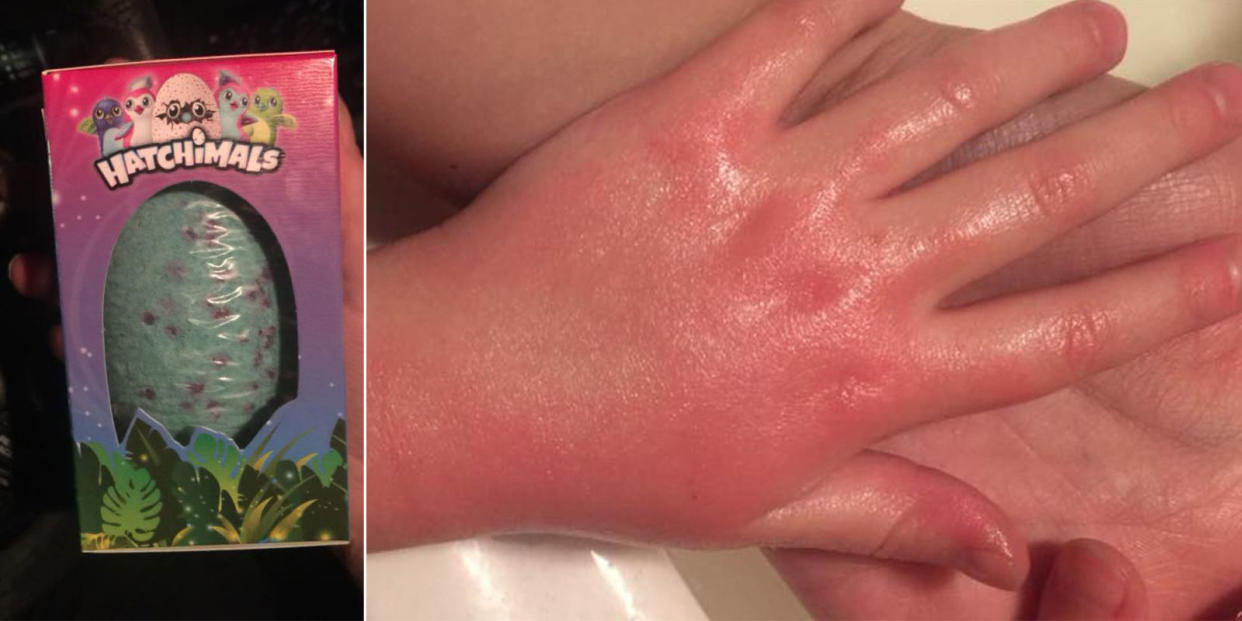Mom Claims Her Daughter Suffered Chemical Burns from a Hatchimals Bath Bomb

A mom took to Facebook with an earnest warning for other parents: beware of Hatchimals bath bombs. In a now-deleted post that was shared more than 10,000 times, Jennifer Renee claims that her daughter, Willow, was left with chemical burns after being in the water with the product for less than a minute.
"PSA! Do NOT buy this for your children," she wrote. "Followed directions on package and placed in her bathtub. Thought it would be fun for her because there was a toy inside. After being in the water 30-45 seconds she stated her skin was hurting, upon looking she has received a chemical burn from a KIDS BATH BOMB. (no she was not holding it and she has used multiple different kinds of bath bombs and never had this reaction). Just a warning people."
This poor girl!
Posted by I Love Being a Mom on Monday, December 11, 2017
"She has had these before and all different brands," Jennifer continued. "I called the company and the batch number being investigated and is likely going to be recalled as numerous reports have been made (not all the burning reaction she got). It is so easy for a person working in a factory to overdo the ingredients in a batch and just ignore it. Went to the doctor this morning and it was in fact a chemical burn not a reaction. I am posting this just in hopes people will monitor closely."
The post has received dozens of comments ranging from sympathy for the little girl to worried remarks from parents who'll be returning the ones they bought, to heated debate over the difference between an allergic reaction and a chemical burn, with Jennifer saying that what happened couldn't be an allergic reaction because her daughter "uses bath bombs all the time."
However, just because a person hasn't had an allergic reaction to something in the past doesn't mean that type of product can't eventually cause one.
"Ruling out an allergic reaction just based on someone's history using similar products may not always be reasonable," explains Birnur Aral, Ph.D., Director of the Good Housekeeping Institute Health, Beauty, and Environmental Sciences Lab. "It is also possible that the water was hotter than usual or that the girl's skin barrier was compromised before the bath."
That said, Dr. Aral assumes the doctor's diagnosis of a chemical burn is probably correct.
"A chemical burn occurs when skin has a negative reaction to an irritant, like soaps and detergents. Chemical burns are red, swollen, and sometimes ulcerated, and they appear immediately after exposure in the area of contact," Dr. Aral says. "The description of the girl complaining of her skin burning within a minute supports the chemical burn diagnosis."
According to Dr. Aral, none of the ingredients listed on the pictured packaging are obvious suspects for such a harsh reaction. However, "it is always a possibility that the product hasn't been formulated well or that something went wrong during manufacturing where a harsher contaminant got into the formula."
Also in the Facebook post's comments are screenshots of messages Jennifer received from other parents saying their child had a similar adverse reaction to the same product. However, because the initial post and subsequent messages are anecdotal, Snopes notes that Hatchimals bath bombs being unsafe to use is currently unproven. The site reached out to the makers of Hatchimals, Spin Master, Ltd., and received this comment:
Spin Master was made aware of the situation via a Facebook post and we are in the process of looking into the matter with the licensee company to whom Spin Master licensed the Hatchimals brand. We are saddened to learn about a young girl's injuries. That said, it would be premature to comment further on the situation until we learn more. We are working closely with the product's licensee manufacturer and distributor to determine whether there are any product issues.
Because of her personal experience with the Hatchimals bath bombs, Jennifer says she'll be purchasing "all natural ones from now on," but Dr. Aral warns that's not guaranteed to be any safer than using a product with synthetic ingredients.
"There are plenty of natural ingredients that can be potential irritants, such lavender oil, tea tree oil, and natural fragrances," all of which are often found in bath products, Dr. Aral says. Instead, she recommends choosing fragrance-free products that contain mild or soap-free cleansers, and using bath bombs only once in a while.
GoodHousekeeping.com reached out to Global Brands Group, the product's distributor, for comment and has not yet received a response.
You Might Also Like


